
Advancements in Software Vulnerability Detection Methodologies
/ 4 min read
Quick take - Recent research emphasizes advancements in software vulnerability detection through improved data sanitization techniques, aiming to enhance accuracy and risk management strategies for organizations in response to growing cybersecurity threats.
Fast Facts
- Recent research emphasizes advancements in software vulnerability detection through improved data collection and multi-step sanitization processes, enhancing accuracy and risk management.
- Key components of the sanitization process include normalizing vendor information and simplifying version numbers to reduce discrepancies in vulnerability identification.
- Enhanced data sanitization leads to more precise vulnerability detection, enabling organizations to proactively address security threats and standardize identification across platforms.
- The research highlights the importance of adapting to evolving cybersecurity threats, empowering organizations to develop robust risk management strategies.
- Future directions include integrating threat intelligence, developing comprehensive vulnerability management systems, and enhancing reporting tools for better stakeholder communication.
Advancements in Software Vulnerability Detection: Enhanced Data Sanitization Techniques
In the ever-evolving landscape of cybersecurity, recent research has spotlighted significant advancements in software vulnerability detection methodologies. These advancements focus on the utilization of sophisticated data collection tools and comprehensive sanitization processes, aiming to enhance the accuracy of vulnerability identification and improve risk management strategies for organizations.
Core Objectives of the Research
The research is anchored on two primary objectives: effective data collection using Osquery and the implementation of a multi-step sanitization process. This dual approach is essential for standardizing software data, which is crucial for accurately identifying vulnerabilities.
Key Components of the Sanitization Process
The multi-layered sanitization process is designed to bolster the reliability of software vulnerability detection. It involves several critical steps:
-
Normalizing Vendor Information: By standardizing variations in vendor names to a uniform format, discrepancies that could lead to mismatches during vulnerability detection are minimized.
-
Simplifying Version Numbers: This step involves cleaning version identifiers to emphasize core versions, removing unnecessary tags or indicators that could complicate matching efforts.
These techniques highlight the necessity of advanced sanitization and matching processes to enhance vulnerability detection accuracy, pivotal for effective cybersecurity risk management.
Implications for Cybersecurity Practices
The research findings have several implications for cybersecurity practices:
-
Enhanced Vulnerability Detection Accuracy: Improved data sanitization leads to more precise identification of vulnerabilities, enabling organizations to address potential security threats proactively.
-
Standardization Across Platforms: By standardizing data, organizations can ensure consistent identification of vulnerabilities across various software platforms, streamlining their response efforts.
-
Improved Risk Management Strategies: Enhanced detection capabilities empower organizations to develop more robust risk management strategies, essential in navigating the complex landscape of cybersecurity.
-
Adaptation to Evolving Threat Landscapes: The research positions organizations to better adapt to the ever-changing nature of cybersecurity threats, ensuring they can respond effectively to emerging vulnerabilities.
Strengths and Limitations
While the research presents significant strengths, such as integrating powerful tools and techniques, it also identifies limitations and areas for further investigation. Addressing these challenges will be crucial for the continued evolution of effective software vulnerability detection solutions.
Recommended Tools and Frameworks
Several tools and frameworks were discussed as part of the research, each playing a unique role in enhancing vulnerability detection:
-
Common Platform Enumeration (CPE) Strings: These provide a standardized method for identifying software and hardware vulnerabilities.
-
Osquery: A powerful tool for querying operating systems to gather data relevant to security assessments.
-
Fuzzy Matching Algorithm (RapidFuzz): This algorithm enhances the matching of vendor information and version numbers, improving the accuracy of vulnerability detection.
-
Multi-Layered Sanitization Process: A comprehensive approach to cleaning and standardizing software data.
Future Directions
To maximize the effectiveness of these findings, the research recommends several future directions:
-
Integration with Threat Intelligence Platforms: Creating a more comprehensive view of vulnerabilities by incorporating real-time threat data.
-
Development of a Comprehensive Vulnerability Management System: Streamlining processes for identifying, assessing, and mitigating vulnerabilities.
-
Application in DevSecOps Pipelines: Embedding vulnerability detection within development and operational workflows for real-time security assessments.
-
Cross-Platform Vulnerability Detection: Ensuring effective vulnerability management across diverse software environments.
-
Enhanced Reporting and Visualization Tools: Improving the accessibility and clarity of vulnerability data for stakeholders.
As cybersecurity threats continue to evolve, this research represents a vital step toward more effective software vulnerability detection and management. Organizations are encouraged to explore these advancements further to bolster their cybersecurity defenses.



